Civil Procedure—Highly Tested MBE Topics, Charts, and a Checklist!
Civil Procedure—Highly Tested MBE Topics, Charts, and a Checklist!
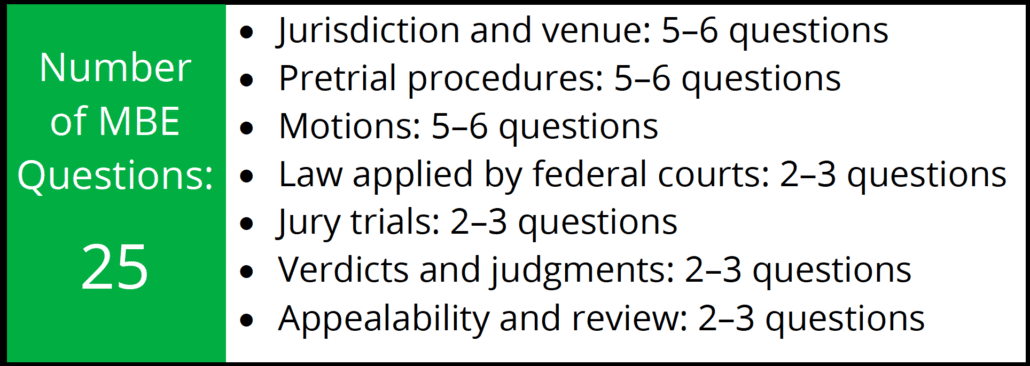
1. Personal Jurisdiction
Personal jurisdiction is all about fairness to the defendant.
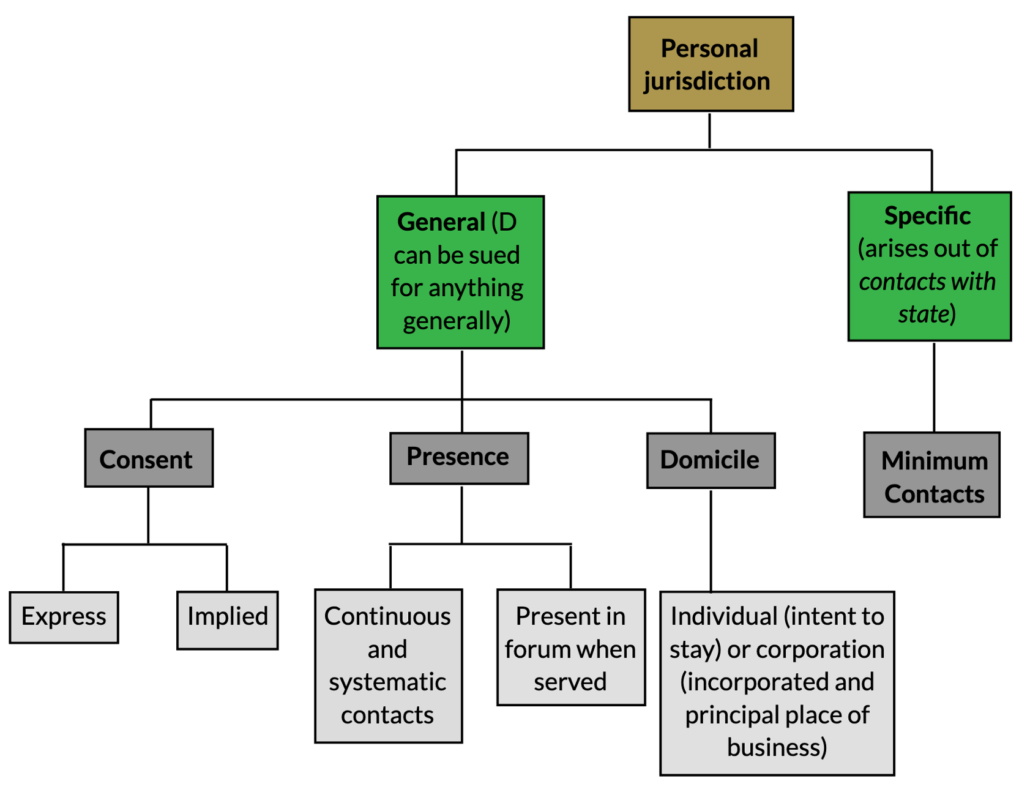
Personal jurisdiction is the power of a court to hear a case over a particular person. There are two types of personal jurisdiction: general personal jurisdiction and specific personal jurisdiction.
- General personal jurisdiction: Does not arise out of the defendant’s contacts with the state. General personal jurisdiction exists when (1) the defendant consents to personal jurisdiction, (2) the defendant is present in the state, or (3) the defendant is domiciled in the state.
- Consent
- Express consent (e.g., defendant signs a contract agreeing to the court’s personal jurisdiction over him
- Implied consent (e.g., defendant fails to object to personal jurisdiction in his first response)
- Presence
- Continuous and systematic contacts with the state
- Present in state when served (“tag jurisdiction”)
- Domicile
- An individual is domiciled where they have a permanent home and intend to stay indefinitely.
- A corporation is domiciled in their principal place of business and in the state of incorporation.
- Specific personal jurisdiction: Must arise out of the specific contacts with the state (i.e., a tort committed in the state, a contract or business transaction arising out of contacts with the state). For specific personal jurisdiction to be constitutional, the state and the S. Constitution must grant personal jurisdiction.
- Constitutional under state constitution: many states have long-arm statutes that enumerate specific contacts that will grant specific jurisdiction.
- Constitutional under U.S. Constitution: There must be minimum contacts so as to not offend traditional notions of fair play and substantial justice. If the defendant has purposefully availed himself of the benefits and protections of the state, the minimum contacts standard has likely been met.
- Consent
2. Subject-Matter Jurisdiction
Remember this is all about the power of the court to hear a certain kind of case. Most state courts have very broad subject-matter jurisdiction whereas federal courts have limited jurisdiction.
There are four categories of federal subject-matter jurisdiction conferred by Congress shown in the chart below.
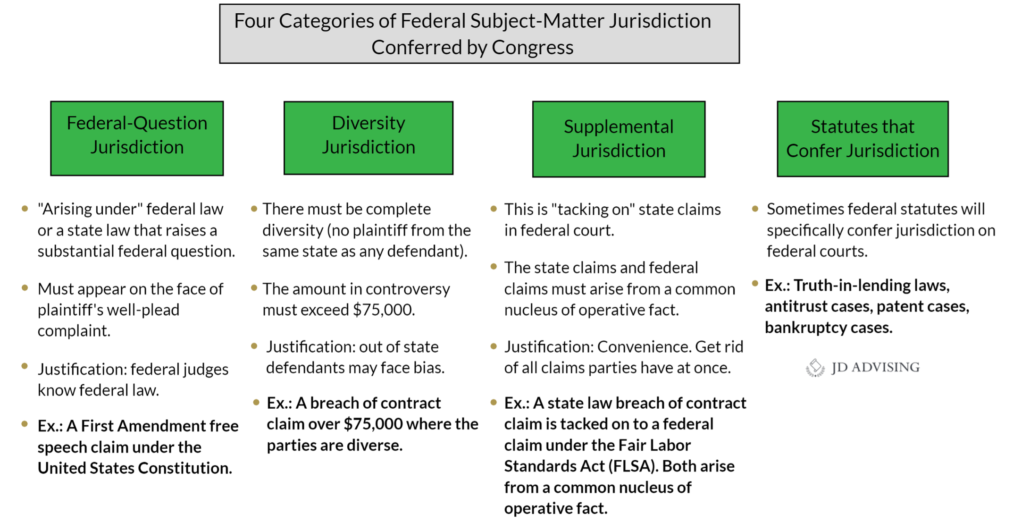
A few things to keep in mind regarding types of subject-matter jurisdiction of federal courts:
- Federal-question jurisdiction: It must arise out of federal law. The federal issue must be on the face of the plaintiff’s well-plead complaint. Note: Do not look at defendant’s defenses or his counterclaims in deciding if there is a federal question! (He lost the race to the courthouse so his claims and defenses do not determine which court hears the case!)

- Diversity jurisdiction: there must be complete diversity at the time the case is filed, and the claim must be over $75,000. The justification of this is to prevent prejudice to the outsider.
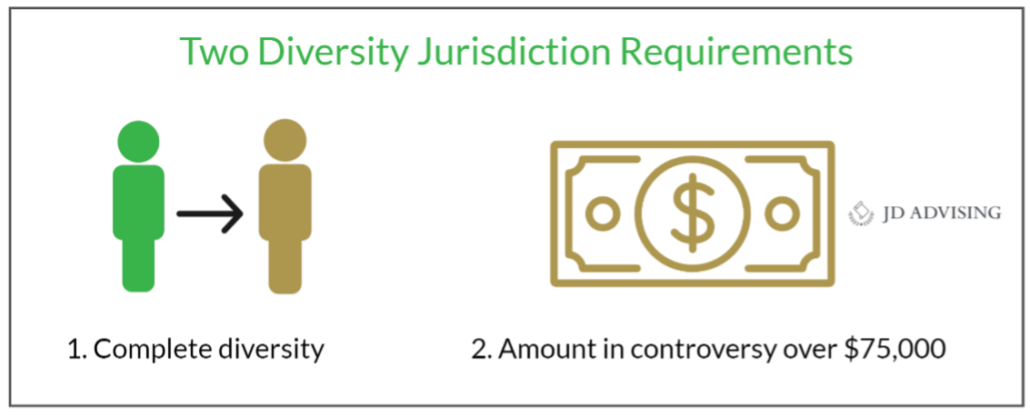
- Knowing where each party is domiciled is very important to getting these questions correct!
- A person: A person is domiciled in only one state—a state that is her home where she intends to stay indefinitely.
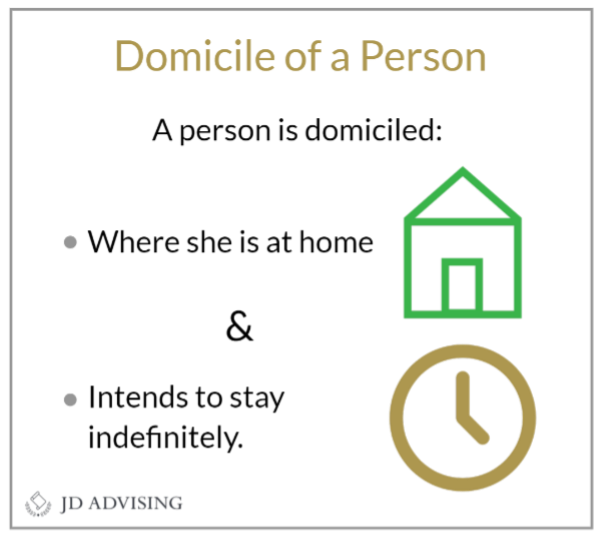
-
- A corporation has two domiciles:
- the state in which it is incorporated, and
- the state where its principal place of business is located.
- A corporation has two domiciles:
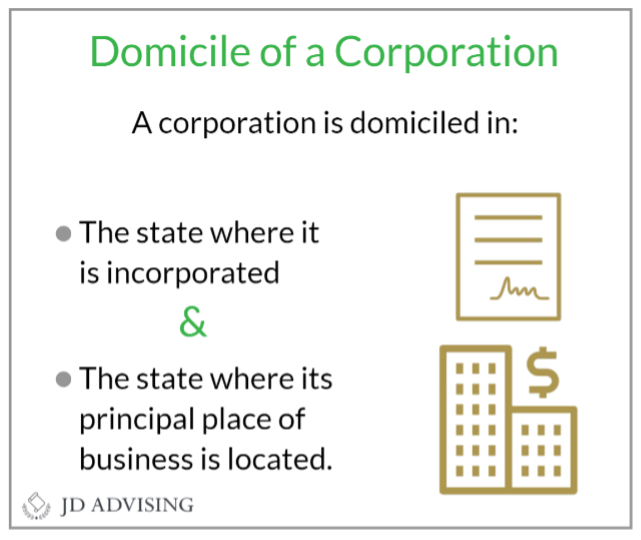
Note that so long as the plaintiff in good faith alleges the claim is over $75,000, this requirement is met unless there appears to be a legal certainty that the claim is really worth less. A plaintiff may add the value of her claims together against a single defendant to exceed this amount. In general, different plaintiffs may not (unless they are seeking to enforce “a single title or right in which they have a common or undivided interest”).
- Supplemental jurisdiction: This is tacking on state claims to federal claims or allowing defendants in diversity cases to implead non-diverse parties. The federal court has discretion to assert supplemental jurisdiction over both claims if they derive from a common nucleus of operative fact (even if the supplemental claim is a state law claim, or even if it does not exceed $75,000).
- This comes up when there is a jurisdictional basis for one claim but not the other—for example a plaintiff asserts a federal claim and wishes to tack on a state law claim, or a defendant or third-party defendant (who is added after the initial lawsuit) asserts a claim against the plaintiff.
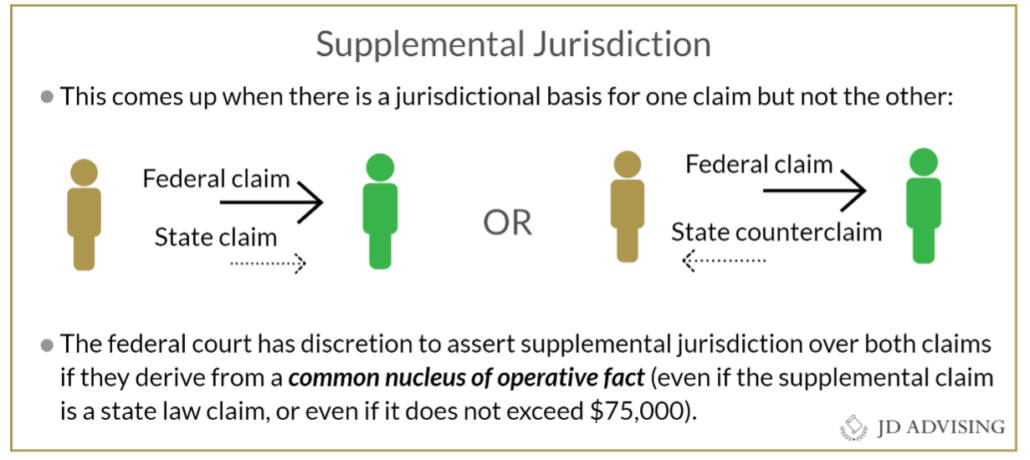
-
- In diversity cases, the court is very lenient in allowing defendants to implead non-diverse parties but generally does not allow plaintiffs to do so. Courts do not want plaintiffs to try to “get around” the diversity requirement by adding a non-diverse defendant after the case is filed. Keep this in mind as it is highly tested!
- Removal: Cases must be removed by the defendant within 30-days of when the defendant realizes the case is removable (but not over a year in diversity cases). Defendants cannot remove on the basis of diversity if any defendant is from the state where they are sued.
3. Venue
So, the state has personal jurisdiction over the defendant—where in the state do you sue?
- Venue is proper:
- in a district where any defendant resides if all defendants reside in the same state; or
- in a district where a substantial part of the events or omissions giving rise to the claim occurred, or a substantial part of the property that is subject to the action is situated; or
- if venue cannot be established by the above provisions, venue is proper where any defendant is subject to the court’s personal jurisdiction with respect to such action.
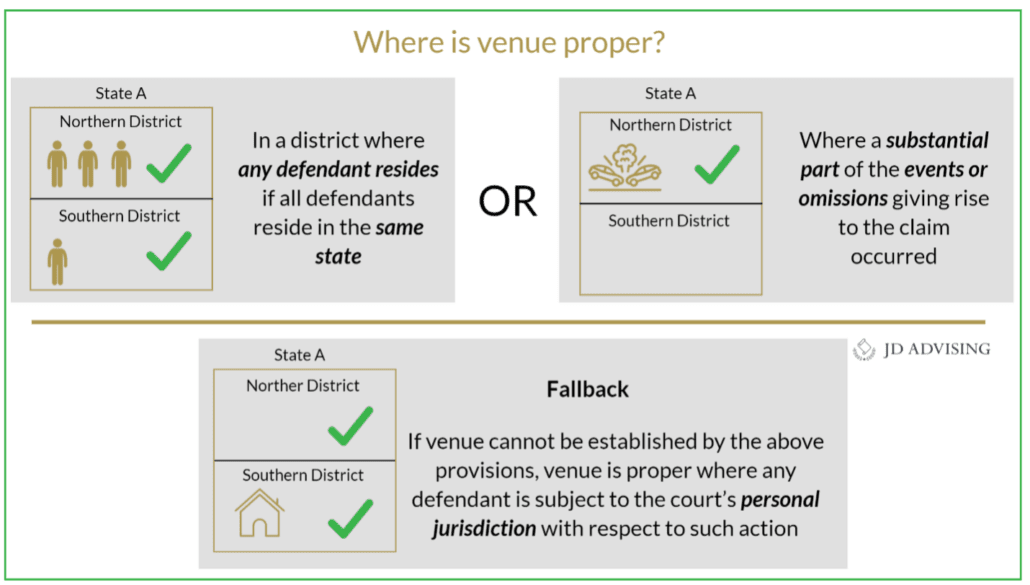
-
- Note: Venue may be waived by the defendant if she does not object to the complaint in her first response. A defendant must object right away to preserve an objection to venue.
- Removal from state court: If an action is removed from state court, it goes directly to the federal court of the district in which the state action is pending. Ignore these venue rules.
- A court may transfer to a proper venue (if venue is improper), or a more appropriate forum.
4. Service
You are ready to start the lawsuit. How do you let the defendant know about it?
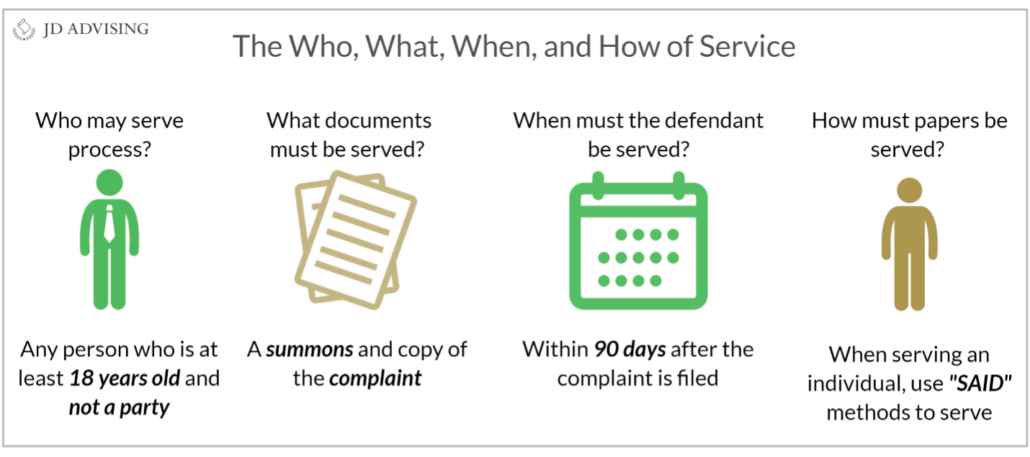
- The process server must be over 18 and not a party to the case. They must serve within 90 days after the complaint is filed.
- Serve the defendant with a summons and copy of the complaint. You can follow the state law service methods where the federal court is located or where service is made.
- Ask defendant to waive formal service of process. They will pay attorney’s fees and costs to make formal service of process if they do not. They get 60 days (instead of 21) to answer the complaint if they do.
- Use one of the appropriate methods to serve an individual. See the “SAID” method below.
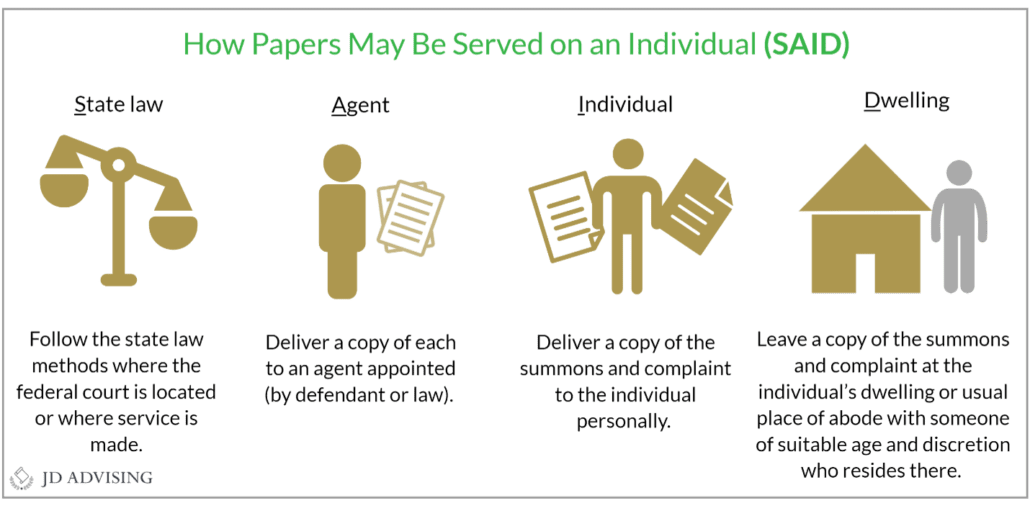
5. The Erie Doctrine
This is only an issue when there is a state law claim in federal court (under diversity or supplemental jurisdiction).
- Federal law generally applies to procedural issues (Federal Rules of Evidence, civil procedure, when to bring a class action, right to a jury trial, etc.).
- State law generally applies to substantive issues (which party has the burden of proof, which statute of limitations apply, caps on damages, elements of claims or defenses, choice of law rules).
Note: Many students struggle with the Erie doctrine. However, the good news is that you do not have to know the Erie doctrine in nearly as much detail as you may have learned it in law school! Typically, when the Erie doctrine is tested on the MBE, the examiners test one of the below issues (e.g., bifurcation, class actions, etc.).
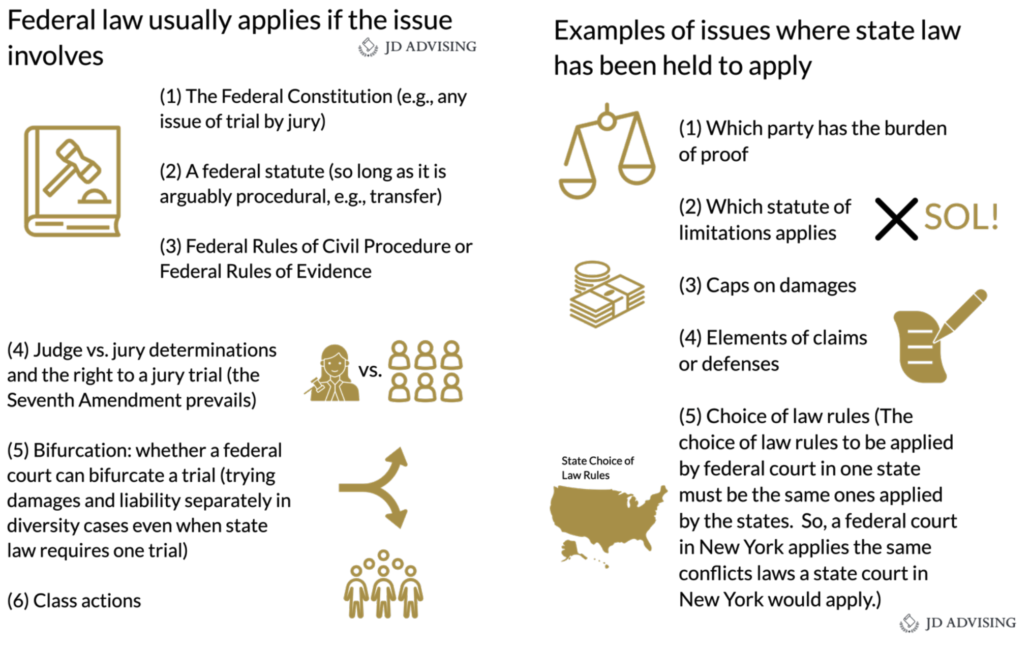
6. Crafting the Lawsuit
This tells you when and what to file and when to respond.

- File complaint and serve within 90 days.
- Response (answer or complaint) must be served within 21 days (or 60 if formal process was waived). An answer may be amended as of right within 21 days.
- New claims can relate back to the initial date to conform to the statute of limitations. New parties may generally not “relate back” to the initial filing.
- Once you have one claim, bring them all! This applies whether you are the plaintiff bringing a claim, or a defendant counterclaiming (suing the plaintiff) or crossclaiming (suing someone on the same side of the “v.”—like another defendant).
- Federal law recognizes compulsory counterclaims where the defendant has to bring a counterclaim if it arises out of the same transaction or occurrence.
7. Pretrial Motions
Pretrial motions: the timeline for bringing motions
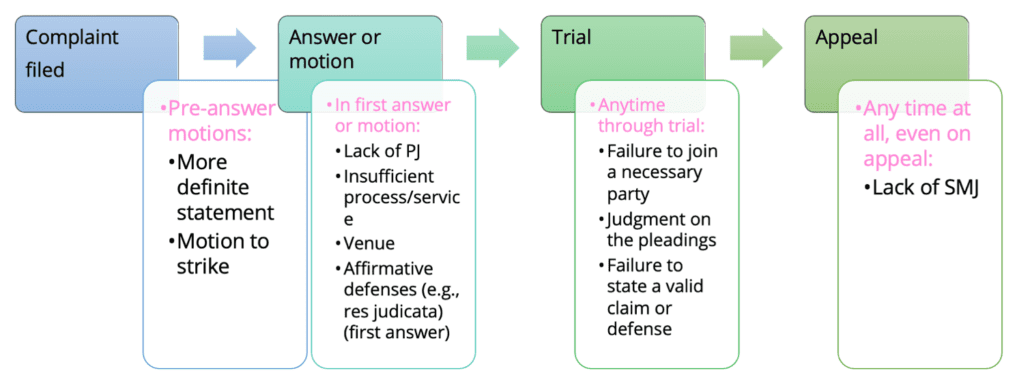
- The following must be raised in a pre-answer motion:
- Motion for a more definite statement
- Motion to strike
- The following must be made in the first responsive pleading (answer or motion):
- Lack of personal jurisdiction
- Insufficient process or service of process
- Improper venue
- Affirmative defenses (like res judicata, statute of limitations)
- The following can be raised at any time:
- Failure to join a necessary party
- Judgment on the pleadings
- Failure to state a valid claim or defense
- The following can be raised any time at all (even on appeal):
- Lack of subject-matter jurisdiction
- Dispositive motions: Summary judgment motions are granted if there is no genuine issue of material fact. The moving party must support its motion with evidence, which shifts the burden to the nonmoving party.
8. Class Actions

- Class actions: you need commonality, adequacy, numerosity, typicality, and (with “common question” suits) you need superiority and to show that common questions predominate.
- Class Action Fairness Act (CAFA) allows federal courts to have jurisdiction if there are 100 or more plaintiffs seeking over $5 million and have minimal diversity.
9. Pretrial Procedures: Injunctions, Discovery, and Sanctions
- Temporary restraining orders (TRO): notice is not needed. Preliminary injunctions: notice is needed. These can be appealed.
- Discovery: Parties may discover anything that is relevant and not privileged. Relevant information need not be admissible at trial so long as it appears relevant and proportional to the needs of the case.
- Work product is not discoverable unless there is a substantial need and undue hardship. However, an attorney’s mental impressions are never discoverable.
- In federal court, there is the 26(f) conference where initial disclosures of DISS are made (damages calculation, insurance, supporting witnesses, and supporting documents).
- Interrogatories: 25 per side and a duty to supplement if information changes.
- Request to admit: deemed admitted unless a sworn denial is sent.
- Depositions and subpoenas: The only method that can be used on a nonparty. (Just 10 per side—one day of seven hours.)
- Rule 11 sanctions are made if an improper paper is presented to the court. However, if a motion is made by a party, that party must give them 21 days to withdraw the offending paper.
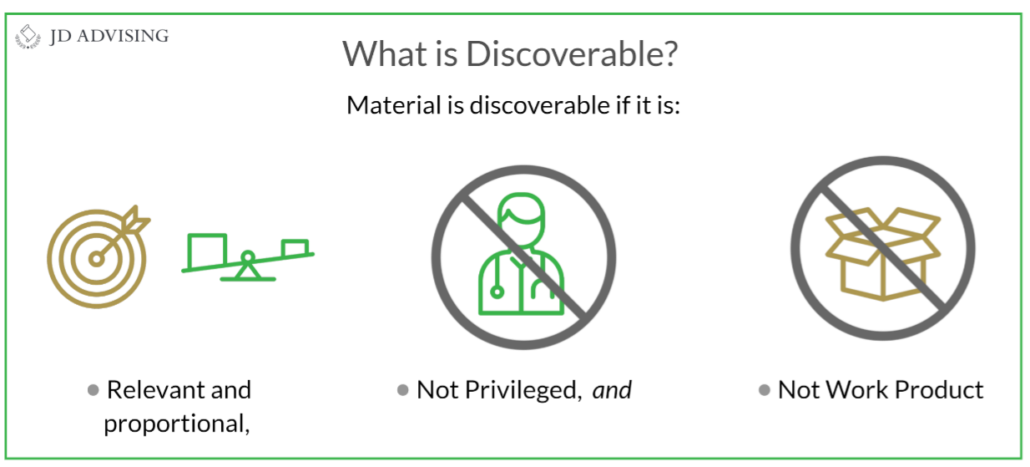
10. Defaults and Dismissals Before Trial
- A default is entered by a clerk if there is no timely answer. Default judgments are made by a clerk for a “sum certain” (can be without notice) or by a judge with notice seven days before entry of judgment.
- A default may be set aside for good cause shown.
- No progress dismissals: these are usually with prejudice (so the plaintiff cannot refile the lawsuit!).
- Involuntary dismissals (for, say, failing to comply with a court order) are usually with prejudice.
- Voluntary dismissals by plaintiff are generally without prejudice.
11. Trial, Verdicts, and Judgments
- Jury trials: the Seventh Amendment requires impartial selection and a jury pool that is taken from a cross section of the community.
- Motion for a directed verdict (judgment as a matter of law [JMOL]): A defendant may file this motion after the plaintiff rests its case. Either may file the motion after the defendant rests its case. If there is no substantial evidence to support a verdict for the nonmoving party, the verdict will be granted.
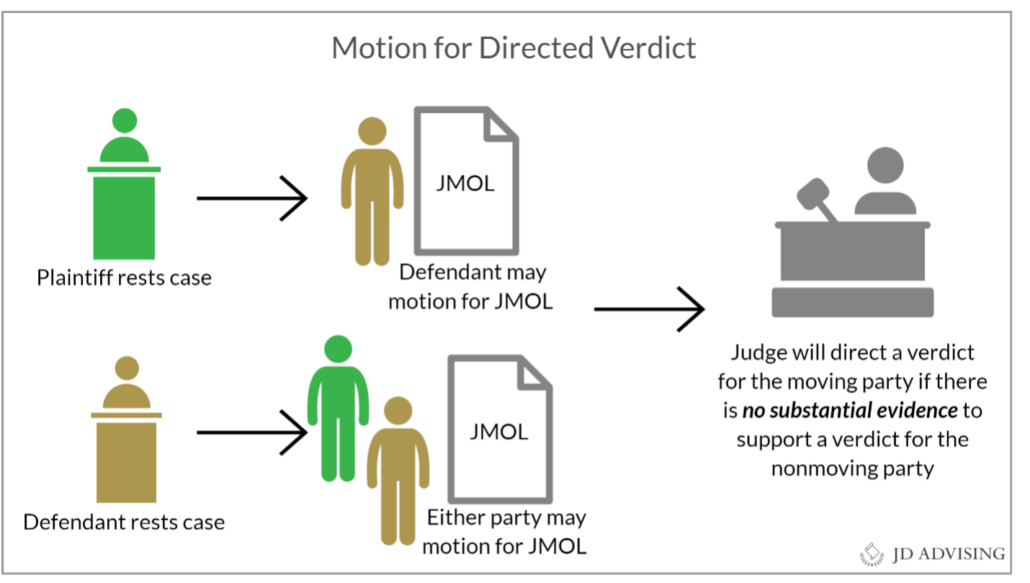
- Motion for renewed judgment as a matter of law (RJMOL) is granted after the jury’s verdict. The initial one must be filed for this one to be filed.
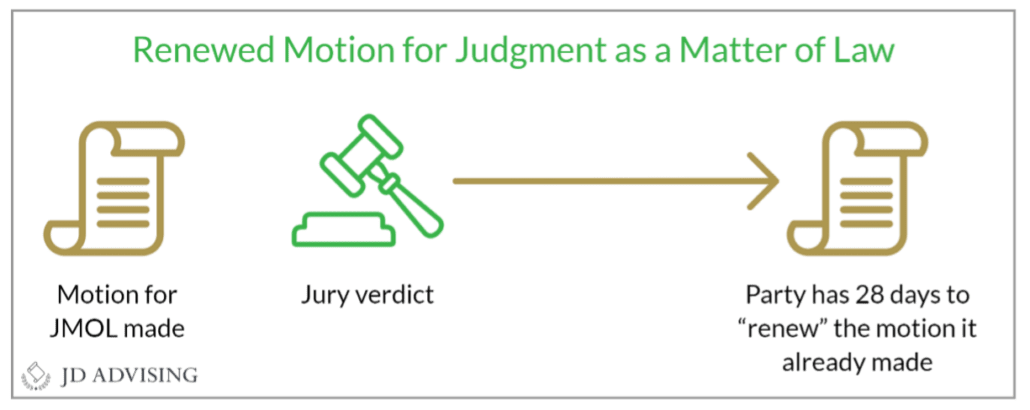
- Motion for new trial: granted if there is an error in the jury’s decision-making process or if the jury’s decision is against the great weight of evidence.
- Final orders are generally appealable. Exceptions are: injunctions, interlocutory orders by leave, and final orders in cases involving multiple claims and parties.
12. Claim and Issue Preclusion
- Claim preclusion (res judicata): Same claim, same parties, final judgment on the merits. Same claim = anything that was brought or could have been brought. “On the merits” = anything dismissed by a full jury trial, summary judgment, and with prejudice.
- Issue preclusion (collateral estoppel): same issue is actually litigated and decided that is necessary to the final judgment.
Res Judicata (Claim Preclusion)

Collateral Estoppel (Issue Preclusion)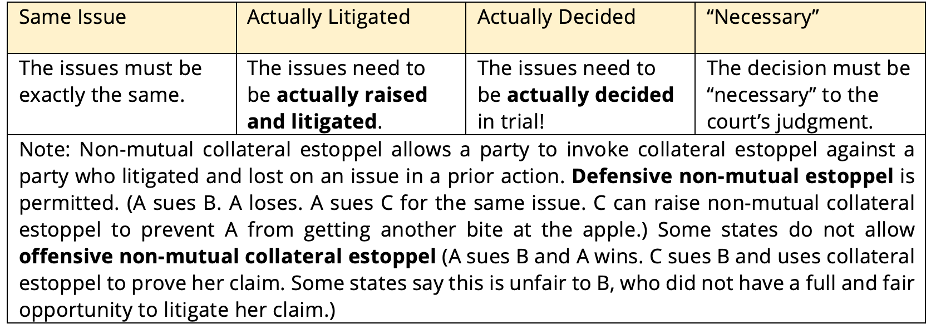
Go to the next topic, Constitutional Law—Highly Tested MBE Topics, Charts, and a Checklist!
Seeking MBE Assistance?
Seeking MBE Assistance?
- 📘 MBE Guide: Equip yourself with our FREE expert-crafted bar exam and MBE guides.
- Free Bar Exam Resource Center: Discover top resources, articles, and free webinars led by renowned bar exam professionals.
Top Resources as Vouched by our Students:
- MBE One-Sheets: One of our most highly acclaimed bar exam supplements!
- Bar Exam Outlines: Our comprehensive and condensed bar exam outlines present key information in an organized, easy-to-digest layout.
- MBE Private Tutoring: Opt for personalized, effective strategies.
- On Demand Bar Exam Course: Comprehensive bar exam preparation.
- Bar Exam Crash Course and Mini Outlines: Acclaimed and effective for a quick refresher.
- MBE Mastery Class, Real MBE Questions, and MBE Guide: Elevate your MBE preparation with these high-quality MBE supplements!
🔥 NEW! Check out our Repeat Taker Bar Exam Course and get introduced to our unmatched platinum Guarantee Pass Program.

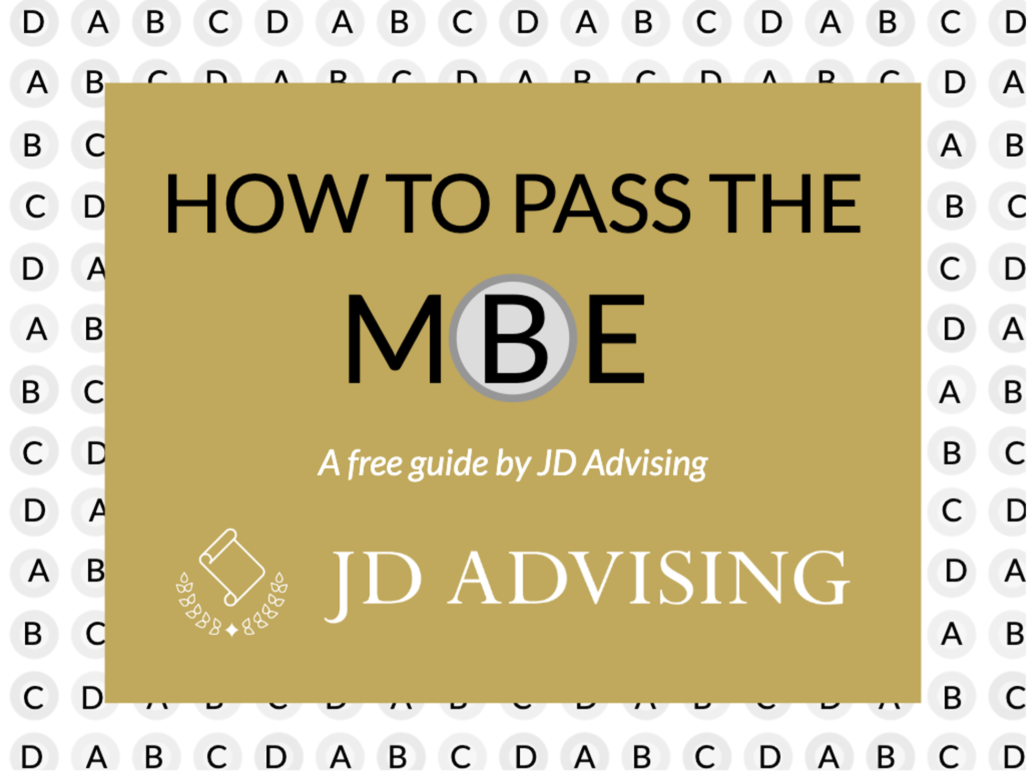
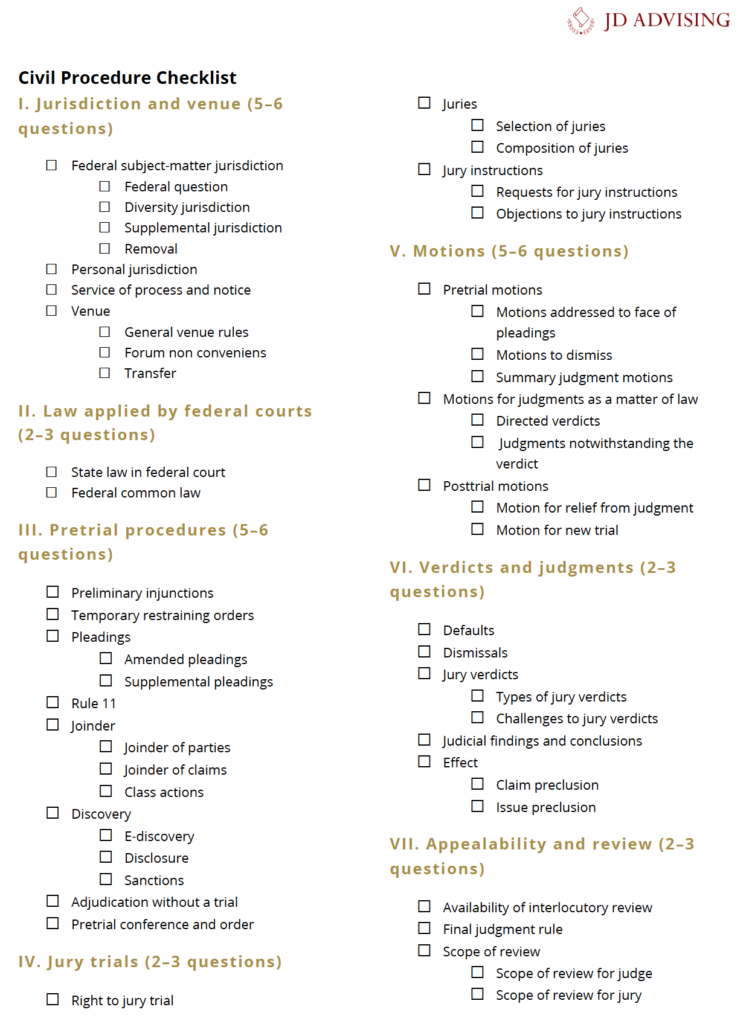
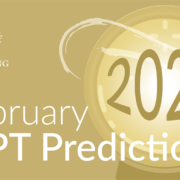



Leave a Reply
Want to join the discussion?Feel free to contribute!